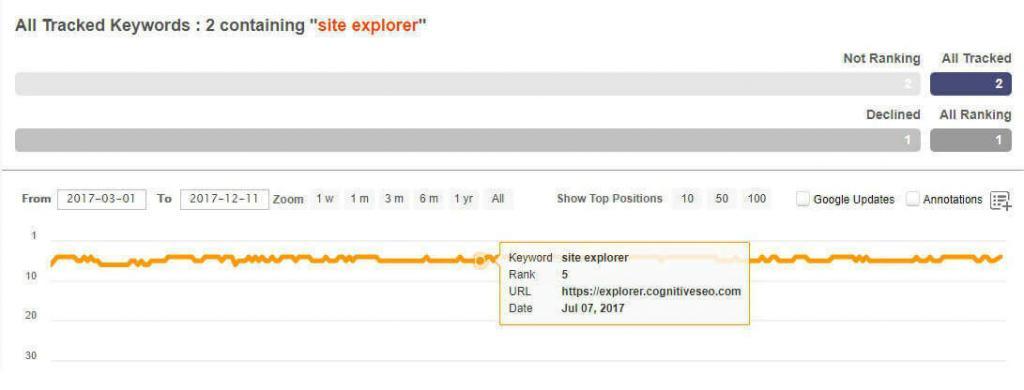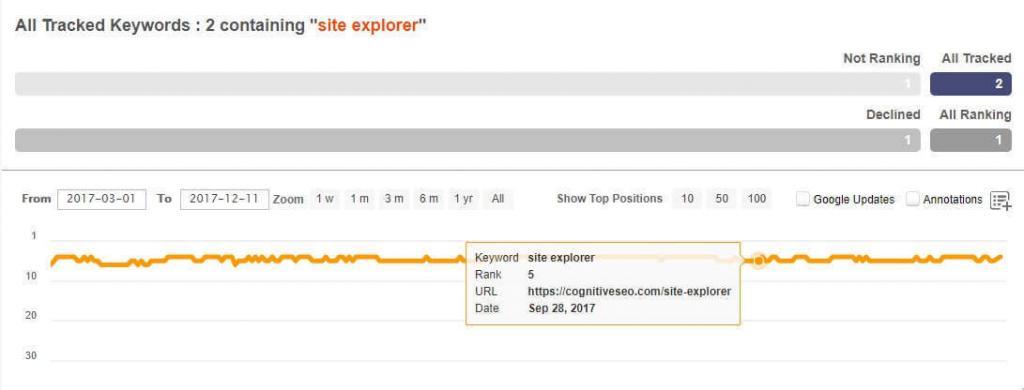The subdomain vs. subdirectory question has been around probably ever since Google first appeared. People ask themselves if having one or another affects SEO. The popular belief is that switching from a subdomain to a subfolder of the root domain will help increase the overall rankings of your website.
But is that true?
The short answer is… it depends. But if you’re asking yourself which one you should use and you want to make a very documented opinion on the subject before you take any action, I recommend that you give this article a good read.

- cognitiveSEO’s Subdomain to Subdirectory Switch Story
- Successful Subdomain to Subfolder Switch Stories
- What Do the Experts Have to Say About Subdomains vs. Subfolders?
- To Move or Not to Move, That Is the Question
I took the effort to collect some stories of people who made the switch. I also asked a bunch of SEO experts around the world what they think about it, so we can have a really good idea of what different people think about this subject.
But, before we get into that, I’ll tell you a short story about our own experience with switching from a subdomain to a subfolder.
Or, you can miss out on everything else (bad idea) and click here to skip directly to the answer.
1. cognitiveSEO’s Subdomain to Subdirectory Switch Story
In the summer of 2017, during the launch of our Keyword Tool and Content Assistant, we considered using a subfolder instead of a subdomain (as we had previously used for the Site Explorer). This would mean cognitiveseo.com/keyword-tool instead of keyword-tool.cognitiveseo.com.
We had to find out for ourselves if this switch would somehow improve the page’s performance.
To avoid user confusion and keep both tools on similar paths, we decided to also move the Site Explorer from https://explorer.cognitiveseo.com to https://cognitiveseo.com/site-explorer/.
The change happened the very late June, although the search engines and ranking trackers noticed the change a little bit later, in early July.
So… what do you think happened? Well… Nothing
Contrary to popular belief, no improvement was seen whatsoever. Here are some screenshots from our rank tracker, over the past year. You can clearly see the moment when Google noticed the change and indexed it accordingly:

Screenshot from the cognitiveSEO tool’s Rank Tracker showing the positions before the switch.

Screenshot from the cognitiveSEO tool’s Rank Tracker showing the positions some time after the switch.
As you can see, from March till December, rankings have been fluctuating very little, with the overall position keeping itself around 5th.
Showing analytics data isn’t actually helpful, as traffic always fluctuates and our traffic might be naturally up or down a little month by month. But just for the record, the traffic reflects the rankings, so no, we can’t say we’ve noticed any improvement.
Ok, so now we know. Switching from a subdomain to a subdirectory doesn’t improve traffic, right? Not so fast… keep reading.
2. Successful Subdomain to Subfolder Switch Stories
Our story might not reflect this, but there are a lot more stories from other people that say something else. Here are just a few of them which claim that switching from a subdomain to a subdirectory of the main domain will positively impact rankings and traffic. They also state that it’s a rather quick result.
Compared to us, these websites moved entire sections on the main domain, instead of just a single page.
2.1 HotPads’ Blog Switch Story & The Overnight Traffic Doubleing
Jonn Doherty, founder at GetCredo tested the switch myth on HotPads.com blog. Here’s the tweet that caught my attention:
@randfish we moved the HotPads blog from subdomain blog. to /blog. Guess where that happened. pic.twitter.com/guLMN6HluX
— John Doherty 🤓 currently in Chamonix
(@dohertyjf) February 7, 2015
Although the tweet wasn’t very detailed, John took the time to reply to an e-mail I sent. I’ll take a brief moment here to thank him for this.
Here are the questions I asked and his answers:
Why did you decide on making the change from subdomain to subdirectory?
“We decided to make the change from subdomain to subdirectory because I believed it would be better for SEO. We had an old blog on TypePad that looked outdated because we were updating the site as a whole, and I had just hired a content manager and I wanted our content to have a fighting chance to be read/shared. We replatformed to WordPress at the same time and eliminated a bunch of old content, and did the proper 1:1 301 redirects.”
Were you afraid it would go bad?
“No, I was not afraid because we were working off such a low base of traffic.”
When did the merge take place, and when did the traffic start to rise?
“This was a few years ago so I am not positive on the timing, but if I recall correctly it was around February 2014 and we saw an impact almost immediately.”
Would you recommend this to others?
“From an ideal SEO perspective, for sure. I saw the impact personally as have many others, so in my opinion it’s not really a debate anymore whether or not it works. The question is really if it’s worth it strategically, within a broader view of the company’s goals and directions, to push for it or not.
It’s not a small change to make, and unless you have a backlog of content built up that you need to rank better to improve your business and you are investing in active content development and need that to rank, it might not be worth your time to prioritize over other things that will actually move the needle on your business revenue-wise, depending on your business of course.”
Are you sure that the merge was the cause of the traffic increase?
| It was a big part in my opinion. As with anything SEO-related, there were multiple moving pieces and fixes happening when this move was made. It was a combination of all of the things we fixed – moving to a subfolder, replatforming to WordPress, better indexation and blog architecture, and removing low quality content. | |
 |
john doherty |
| Founder at GetCredo / @dohertyjf | |
So the key element to remember from John’s answers is that the switch to the subfolder isn’t the only thing he did during this website update.
I found another similar example, but haven’t been able to get more detailed insights about what exactly happened. Ruth Burr Reedy states on Twitter that Todd Friesen from SalesForce did a subdomain to subdirectory switch and doubled his website’s traffic overnight.
One of the biggest SEO successes @oilman has seen at @salesforce was moving blog from subdomain to subdirectory. Traffic 2x overnight #smx
— Ruth Burr Reedy (@ruthburr) June 23, 2016
There are however two more stories I want to feature, so stay tuned! 
2.2 Iwantmyname Blog’s Switch Story & The Double Bad Luck
This isn’t actually a successful subdomain to subfolder switch story, but more of an unsuccessful one
In a blog post a couple of years ago, Timo shared his website’s experience with the world. In July 2014, he moved his blog from a subfolder to a subdomain, for some particular reasons he had, such as performance with some GitHub Pages implementation, flexibility of the platform and maintainability.
The results? Not cool.

Screenshot from the Iwantmyname blog showing a drop in traffic after switching to a subdomain
The team thought at first that it’s something normal, and that the blog will quickly recover the traffic it was gaining. However, after several months and a lot of reading, they finally decided to move the blog back to the root domain.
| Once we moved the domain back from a subdomain, the visibility improved again, but there was no dramatic traffic increase. We also changed the focus, style of the blog and content shortly after moving it back, so it would be kind of an apples to oranges comparison. | |
| The Iwantmyname team | |
| https://iwantmyname.com | |
Although the recovery can’t be attributed to the switch back to the root domain, the initial switch to to subdomain clearly took their traffic down. The Iwantmyname team went through bad luck twice in a row.
2.3 Craig Emerson’s Blog Switch Story
In 2014, Craig Emerson posted an article on his marketing blog, stating his successful story of switching from a subdomain to a subfolder.
One very important thing here that Craig mentions is the fact that, among other facts, he mentions properly linking between his subdomain and the root domain. However, most of the backlinks were built to the subdomain.
This is important for a future part of this article, in the section where we ask the experts.

Craig’s example before the switch
After the switch was done and the proper 301 redirects were set up, Craig saw an improvement in search visibility in about 2 weeks, which by SEO standards is a very short time.

Craig’s example after the switch
| I went from somewhere out of the top 100, and I know for a fact I wasn’t even in the top 200, to being number 57 in the SERP’s simply by changing from a subdomain to a subdirectory. Everything else related to my site remained constant. | |
 |
Craig Emerson |
| Blogger at BloggingFlail / @CraigEmerson | |
This is probably the cleanest example of a successful subdomain to subdirectory switch out there.
Craig’s case is more interesting because in his example, no other change takes place. It’s a clean example of being able to rank higher just by moving your content from a subdomain to the root domain.
3. What Do the Experts Have to Say About Subdomains and Subfolders?
Ok, so these are public stories. However, those stories aren’t even a handful. Experts all around the world deal with this problem everyday, so I decided to ask some of them, and hopefully come up with a final conclusion.
3.1 Eric Enge from Stonetemple
@seo_theory @dharmesh in a vaccuum, I recommend subdirectories, but never worth moving a blog from a subdomain for that reason alone.
— Eric Enge (@stonetemple) February 10, 2015
I asked Eric if this is still his opinion, and he said that he stands by it still. Here are his reasons:
“Google is pretty good at seeing a subdomain as being an integrated part of the main domain. The primary reason that it’s an issue is that it’s very easy to have a subdomain that is operated by a third party. For example, you wouldn’t treat all the subdomains of blogspot.com like they were a core part of the main site. Clearly they’re not, as thousands of people operate blogs on that platform.”
Although Eric believes that Google is good at detecting what subdomains are all about, he still thinks it’s a safer move to keep your blog on your root domain.
| The great majority of the time, Google will understand that your blog on a subdomain is really yours, which is why I say it does not make sense to move them. However, if you are starting a new blog, I recommend that you put it in a subfolder, not a subdomain. | |
 |
Eric Enge |
| Founder & CEO at StoneTemple / @stonetemple | |
3.2 Sam Silverwood Cope from PI-Datametrics
In one of his articles on PI-Datametrics Sam addresses an issue where multiple subdomains start eating each other out in the serps, and often times competing with the main domain.
Although this only applies to the websites that use subdomains mainly as a form of posting content, this could be also the case for subdirectories.
But what I found interesting was the following thing:
| As we’ve seen, Google used to offer up separate results for separate subdomains, so that multiple subdomains would feature in the SERPs. However, since this practice was ultimately being abused, Google now ‘scrunches’ those results together. This is a good example of everyone suffering from the practices of a very few. | |
 |
Sam Silverwood Cope |
| Co-Owner at PI-Datametrics / @scopey123 | |
This goes spot on after Eric’s post. The rankings on your subdomain could be affected by the fact that Google thinks your subdomain is some sort of third party platform and shouldn’t get the same authority as the root domain.
3.3 Stephen Kenwright from Branded3
Stephen wrote about this top in the summer of 2017. Although his article was more about TLD’s, he also covered subdomains a little.
He says that subfolders are almost always preferable over subdomains, except when the use of subfolders is impossible due to technical reasons.
| I’ve worked with several brands who have experienced an increase in organic traffic when migrating from international subdomains to international subfolders – this usually occurs when there’s a lot of link equity in one or two countries and less-favored international sites are underperforming. | |
 |
Stephen Kenwright |
| Strategy Director at Branded3 / @stekenwright | |
To better explain the quote, if a brand from the United Kingdom is marketed in the United States for a period of time, and a lot of links are gained on the main domain, other languages versions that are found on subdomains might see an improvement in their countries if they are merged into the main domain as subfolders.
He does however state that a merge is not easy to do, and there are also risks involved (like a drop instead of a grow).
3.4 Gianluca Fiorelli from MOZ
Another tweet that caught my attention was Gianluca’s:
I think @randfish will like a graph like this ⬇️. Results of moving a blog from subdomain to subfolder… pic.twitter.com/ACQOVpY0H0
— Gianluca Fiorelli (@gfiorelli1) March 10, 2017
I decided to e-mail him, and he gave me a very detailed and compelling answer!
| When it comes to the topic of subdomain vs subdirectories, I am not a “Taliban” and, as always happens in SEO, to the question: Are subdirectories better than subdomains for SEO?”, my immediate answer is: “It depends”. | |
 |
Gianluca Fiorelli |
| SEO at I Love SEO / @gfiorelli1 | |
Here’s why Gianluca’s detailed answer about subdomains:
“Generally talking, I think that subdirectories are the best option for many reasons:
- You consolidate the authority and relevancy of all subdirectories in one main domain;
- The positive benefits of each subdomain, now moved to subfolders, will have a direct influence for all the other subdirectories.
Moving a blog from subdomain to subfolder inside the main domain name is a classic example:
In fact – despite whatever Google says – all links earned by a blog in subdomain have a positive effect only on the same blog subdomain, and not on the root domain or on other subdomains of the same root domain name.
If we move the blog to a subfolder inside the main domain, the uplift in traffic and rankings is almost a mathematical consequence (you can use the tweet you linked in your email to reinforce my phrase).
Another good example is international SEO:
When we decide to target a new country market, the best idea is starting targeting it creating a geo-targeted subfolder, so to give it a first “authority boost” thanks to an optimized internal linking. Only when (and if) the targeted market starts offering valuable metrics in terms of traffic and conversions, then we can think in moving that subfolder to an independent domain name for better localization and more focused targeting.
However, there are cases when a subfolder may be not the ideal solution, mostly for technical reasons. An example can be a big Ecommerce website.
In that case, if the “separate domain name” option is not possible (i.e.: for branding reasons, being the branded domain not available), choosing to develop a version of our Ecommerce targeting a different county or language can be a valid solution.
Said that, albeit a personal preference toward subfolders vs. subdomain (and backed up by proof), all solutions have their pros and cons, and everything – at the end – should be deemed to something that goes further any SEO consideration: business needs.”
3.5 AJ Ghergich from Ghergich & Co.
Mr. Gherghich says that all of his clients are advised to keep their content on the root domain, so they can gain all the authority there.
| I advise clients to hoard all domain authority and link equity on their root domain. I’ve seen many cases where sites have benefited from consolidating multiple subdomains to one root domain. However, I would be hesitant to move a long-standing subdomain that already ranks. You must take it on a case by case basis. | |
 |
A.J. Ghergich |
| SEO at Gherghich & Co. / @SEO | |
However, due to the volatile nature of this subject, all cases should be analyzed separately. Therefore:
- New sites should build on the root domain if possible
- Subdomains with little to no traffic should be consolidated to the root domain
- Subdomains with solid existing rankings should be hesitant to move to the root domain
AJ’s quote states multiple subdomains were consolidated to the root domain. In this case, an improvement in visibility might be seen because of the high amount of ‘new’ content the root domain is having.
3.6 Barry Schwartz from Rusty Brick
It seems like Barry kind of agrees with Matt Cutts and John Mueller about the subdomains thing. He actually wrote about this on Search Engine Roundtable.
And even his answers are quite short, I do appreciate the fact that he took the time to share with us his opinion on this.
Do you think people should people use subdirectories instead of subdomains?
Doesn’t matter.
Is the effort of changing subdomain to subdirectory worth it?
No.
Does having one or another have any effect in the SERPs?
Doubt it.
I’ve asked many experts about this topic and very few replied. I really appreciate Barry’s answer, as I know he’s really busy keeping us all up to date on Google’s latest quirks and perks.
3.7 Cyrus Shepard from Fazillion Media
I had the honor to hang out with Cyrus this November during a great conference (GPeC Event ). SEOs and SEOettes, without further ado, I present you the gentleman of all gentlemen, Mr. Cyrus Shepard!

The Griffindor team applauding Cyrus’ entrance on John Williams’ music.
Do you think people should use subdirectories instead of subdomains?
“This question has been around for 10+ years, and is likely to be around long after I’m gone. The general consensus is that for most purposes, there are SEO advantages to using subdirectories over subfolders.
Google does its best to associate subdomains with parent domains, but it hasn’t always proved to be a perfect system.
Empirical evidence shows that oftentimes, moving content (such as a section blog living on a subdomain) to a subfolder often results in increased visibility, rankings, and traffic.”
| Although a boost isn’t guaranteed and it’s far from perfect, the reverse (a boost when moving from a subfolder to a subdomain) almost never happens. | |
 |
Cyrus Shepard |
| Founder at Fazillion Media / @CyrusShepard | |
Does having a subdomain or a subfolder affect how your site shows in the SERPs?
“There are 2 things to consider–both of them minor–about how subdomains and subfolders display in the SERPs.
- If you have a long URL, Google may truncate it to fit in search results, which means part of your subfolder may not display in SERPs. That said, this is a very small subset of URLs. Subdomains, on the other hand, start at the beginning of the URL and are therefore aren’t likely truncated.
- Since the subdomain shows before everything else, it’s the first thing visitors are going to see in your displayed URL. A branded or keyword rich subdomain could be of benefit here, but again, it’s a very small difference that in most cases won’t have a significant impact.”
Is the effort of changing subdomain to subdirectory worth it?
“The answer is… sometimes. Many sites go through expensive migrations to see no benefit whatsoever. My standard is this: if the content is thematically close, if there is a lot of interlinking between the subdomains, and the migration can be done with relative ease, it’s often worth the effort. Otherwise, if it’s not broken, no need to fix it.”
3.8 Michael Martinez from SEO-Theory.com
Michael is one of the few who strongly states that switching from a subdomain to a subfolder won’t help you rank better. However, he does have some really solid points, and that’s why I featured him last, because he definitely made me think twice before my final answer.
“Even when my friend Todd Friesen claimed that Salesforce saw an improvement (something like doubled the traffic) I was able to confirm through archive .org that they were using better internal linking structure for the subfolder — and theirs was the absolute BEST case study I have reviewed.”
Michael also properly ‘debunked’ John’s HotPads blog switch. He used web.archive.org to spot the fact that the subdomain wasn’t properly and prominently linked by the root domain.
| Many people attribute the growth in traffic to moving their content from a subdomain to a subfolder because they don’t think to take changes in navigation into consideration. | |
 |
Michael Martinez |
| SEO at SEO-Theory / @seo_theory | |
He states that he never came across a claimed improvement – where he was able to evaluate the before/after versions of the site – that could not be attributed to improved internal navigation. The fault with the SEO case studies is they don’t even mention such changes.
“People screw up their subdomains by not linking to them properly. In all the subdomain vs. subfolder case studies I have read, I have found the subdomains were receiving less link value from the main Website. Often PageRank Sculpting was involved. That is why it looks like moving to subfolders improves things, because people are less likely to attempt to sculpt PageRank these days.”
Well, the other stories I featured before did say that other changes were made, so they could also have had an impact on the outcome. The gain in rankings and visibility can’t be 100% attributed to the switch.
However… we still have Craig’s example, on which the internal navigation and linking was properly done. Or at least that’s what Craig states.
4. To Move or Not to Move, That Is the Question:
To move, or not to move, that is the Question:
Whether ’tis a nobler thing to grow my site as is,
Living with the fear of missing out on traffic,
Or to take arms and risk wasting time,
For what could be possibly nothing.
I should be a poet, shouldn’t I? Hmm… maybe not.
Why didn’t the change have effect on us, here at cognitiveSEO?
Well… First of all, there are very many factors involved in ranking a website. The competitors’ authorities, content, the quality of the product and so on. This is yet another piece of proof that links still matter a lot in 2018+.

Secondly, we only changed one page. ONE. Most stories there that show otherwise tested this with entire sections of their websites.
Another thing that can be taken into consideration is the fact that we’re still linking very much to our subdomain, which is 301 redirected to the subfolder, so at least part of the link juice that flows could be lost. Replacing all the links in the blog is time consuming and isn’t a priority for us right now, but we might consider it in the future.
Our story doesn’t prove that switching to root domains won’t help improve rankings. Nor do the others prove that you will gain rankings if you switch from subdomain to a subdirectory.
Listen to this video of John Mueller from Google and what he has to say:
| If you want to put a blog on your main site in a subdirectory that’s fine, if you want to put it in a subdomain that’s fine, if you want to use a completely different domain that’s possible as well. | |
 |
John Mueller |
| Webmaster Trends Analyst at Google / @JohnMu | |
Nothing new right? He’s saying exactly what Matt Cutts said back in his days as the Head of Spam at Google.
Well, listen to it again, more carefully. John is actually mentioning one more important thing:
He’s saying that you can put your blog on one domain, a subdomain, or a completely different domain and it won’t make an SEO difference.
So if I have my main website on domain.com and my blog on blog.domain.com it’s the same like having my main website on domain.com and my blog on anotherdomain.com? I don’t think so.
Basically, one domain, a subdomain or another domain have no SEO benefits one over the other. But they kind of act like separate domains.
This leads me into thinking that subdomains kind of act like separate domains most of the time.
In fact, it’s all Google’s fault for not providing a definitive answer. But if they provided definitive answers, then SEO would not exist.
Now it’s pretty obvious that root domains do pass some sort of authority to their subdomains, by default. A statement on the BlackHat Forums goes like this:
“It is my belief that main domains DO pass power to their subdomains. If you wanna test this in practice yourself, then go create 2 subdomain blogs: the first on wordpress.com and the second on whatever else free web 2.0 service you might like.”
That is probably very true. The WordPress.com subdomain is going to win/outrank the other web 2.0 service, because it has a lot more authority.
But my question is: Would you rather have your content published on yourname.wordpress.com, or on wordpress.com/your-name/?
Google has definitely made struggles into identifying and treating subdomains as subfolders when necessary. However, it’s not always the case. As Rand Fishkin said in his WhiteBoard Friday, Google MAY pass signals from the subdomain to the main domain. But that’s not a guarantee.
If you’re going to use your subdomain only for the entire site, then it won’t make a difference. The problem here is how authority is passed. If you want to have a blog or multiple pages, you’d better know what you’re doing and link to them properly. Also, consider the fact that the overall authority of the root domain might go down, as it’s not yet sure if subdomains pass link juice to root domains by default.
Conclusion:
Keeping all your content on the root domain is the best thing you can do on the long run, as you can guarantee hoarding all the authority in a single place. It’s just easier to handle from an SEO perspective, especially for a newbie. But if you know what you’re doing, and interlink properly, then using subdomains should be just fine.
I invite you into the comments section, where we can further debate this. Who knows, maybe our discussions will bring up something new.
The post Does Switching From a Subdomain to a Subfolder Improve SEO? Case Studies & Experts RoundUp appeared first on SEO Blog | cognitiveSEO Blog on SEO Tactics & Strategies.
Does Switching From a Subdomain to a Subfolder Improve SEO? Case Studies & Experts RoundUp posted first on http://nickpontemarketing.tumblr.com/
No comments:
Post a Comment